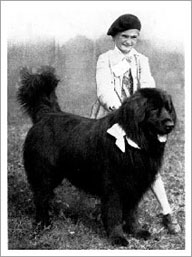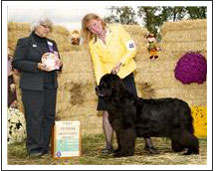ABOUT NEWFS
 Although the exact origin of the Newfoundland isn’t quite clear, all agree that the breed’s native island is Newfoundland on the east coast of Canada. Vikings and Basque fishermen visited Newfoundland as early as 1000 AD and wrote accounts of the natives working side by side with these dogs.European fishermen later traveled to the cod banks of Newfoundland where there were two types of working dogs. The heavier dog was the Newfoundland and the other was the Labrador or the St. Johns breed of Newfoundland. The dogs were used to pull fishnets and heavy equipment. As brave and loyal companions and excellent swimmers, the breed continues to be known today for rescuing people in the water.
Although the exact origin of the Newfoundland isn’t quite clear, all agree that the breed’s native island is Newfoundland on the east coast of Canada. Vikings and Basque fishermen visited Newfoundland as early as 1000 AD and wrote accounts of the natives working side by side with these dogs.European fishermen later traveled to the cod banks of Newfoundland where there were two types of working dogs. The heavier dog was the Newfoundland and the other was the Labrador or the St. Johns breed of Newfoundland. The dogs were used to pull fishnets and heavy equipment. As brave and loyal companions and excellent swimmers, the breed continues to be known today for rescuing people in the water.
Exploring the Northwest with Lewis and Clark
The breed was named during the latter half of the 18th century. In 1780, Newfoundland’s Governor Edwards limited the legal ownership of Newfoundlands to only one per household to promote sheep raising. This decree nearly caused the Newfoundland population to become extinct. Fortunately, some Newfoundlanders were loyal to these dogs and ignored the decree, allowing the breed to survive in Newfoundland.During this time period, the breed also became popular and made their way south. In fact, a Newfoundland accompanied Lewis and Clark on their expedition to the Pacific Northwest coast. In 1860, the breed was included for the first time in a dog show in Birmingham, England. The first Newfoundland was registered with the American Kennel Club in 1879.

Today’s NewFoundland
Most of today’s Newfoundlands can be traced back to an English show dog named “Siki.” Siki and three of his sons were imported into the United States and were bred with the American Newfoundland. This set the standards for the Newfoundland as we know them today.
Newfoundlands are admired and bred in many countries outside of their native land, including the United States, Canada, England, France, Holland, Germany, Switzerland and Italy. In addition to being superior water dogs, show dogs, and excellent companions, some Newfoundlands continue to be used today as true working dogs responsible for dragging carts and moving packs.
Want to learn more about this wonderful breed? Check out our Reading Recommendations.
